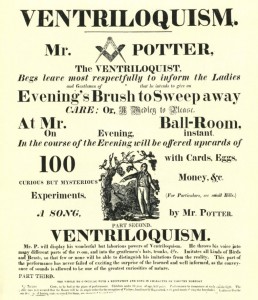
Did you know that America’s first born magician was black? Harry Houdini was a big fan.
Richard Potter, the first American-born stage magician and ventriloquist, black or white. Prior to Potter’s career in the early 19th century, the performance of magic and ventriloquism had been the domain of white European men.
Born in Hopkinton, Mass., around 1783, the year the American Revolution ended, on the plantation of the slave owner Sir Charles Henry Frankland—who may or may not have been his father—Potter set sail for England as a cabin boy when he was just 10 years old. Once there, he met a Scottish magician and ventriloquist named John Rannie, and he was captivated. For years they performed in Europe, but in 1800 they traveled to America, joining a traveling circus and crisscrossing the North and South. (As Jim Haskins and Kathleen Benson explain in their book Conjure Times, Potter was able to travel safely in the South because, in his assistant’s role, he was perceived as Rannie’s servant.) He lived with his father in Hopkinton, NH, until he married his wife, Sally, and had three children.
Potter has been credited as America’s first successful stage magician, hypnotist, and ventriloquist. One of the earliest records of Potter advertising his shows was on November 2, 1811, in Boston at the Columbian Museum. The performance featured ventriloquism and magic.
Potter performed in Boston, throughout New England, and Canada. “Legend” says Potter was able to climb a rope and disappear while performing outdoors surrounded by spectators. Officially, his best-known illusion was “crawling through a log” and Potter could skillfully throw his voice, especially using bird sounds. Whether he was the first to use a ventriloquist’s doll or dummy isn’t known.
Potter lived on a 175-acre farm in Andover that he purchased in 1814, The Potter estate consisted of several rooms on the first floor, the second floor was said to be one big room. The Potter’s would have lavish dinner parties at there home, where he would entertain.
Potter was very successful and it is said that he made $4800 for a 20-day engagement in Alabama in the early 1800’s. Potter’s prestidigitation with eggs, money, and cards was considered of scientific interest, and he often performed at the Columbia Museum in Boston. He could throw knives and touch a hot iron to his tongue, walk on flames, and dance on eggs without breaking them. He performed in New York and all over New England. Charles Brewster, in his history of Portsmouth, NH, refers to Potter as living on what is now State Street. Potter apparently had a son of the same name who performed magic like his father. In 1813, Potter’s success allowed him to buy a 175-acre farm in Andover, NH, in the village now known as Potter’s Place. His story intrigued Harry Houdini, who included Potter in his popular magazine of magic.
From 1818 until 1831 he dazzled audiences up and down the East Coast. By the time he was 50 years old, in 1833, he had stopped performing magic, focusing on ventriloquism. He died shortly afterward, in 1835. Although his house no longer stands, Richard and Sally Potter’s graves remain in Andover, and the town maintains a commemorative plaque in a part of town still known as Potter Place.
Potter died on September 20, 1835. Sometime after his death and the death of his wife, Sally, the couple was buried in the front yard of their estate but the house burned down. Potter and his wife’s graves were moved to their present site in 1849 to make room for the railroad. All that remains to this day is a small plot with the gravestones. Inscribed on Richard’s stone is “In Memory of Richard Potter, the celebrated Ventriloquist, Aged 52 years. Died Sept. 20 1835.
African-American stage magicians were few and far between for nearly two centuries. Henry “Box” Brown, who in 1849 delivered himself from slavery to freedom in a wooden box, performed as a “mesmerizer” during the Civil War era, but his story is significant for reasons beyond magic. In 2014 the magician Kenrick “ICE” McDonald broke down a barrier when he was elected the first African-American president of the Society of American Magicians, an organization founded in 1902 by Harry Houdini, who, incidentally, was reportedly a big fan of Richard Potter’s.
***Information courtesy of The Root and aaeregistry.org***

